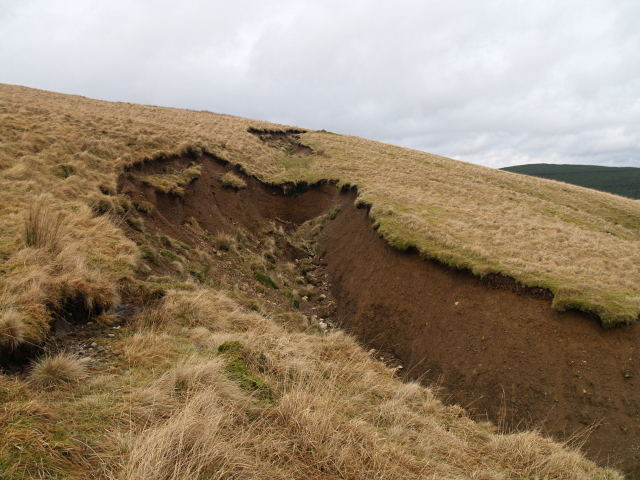Gully
|
This eroded gully was found near Baden Hill in the Scottish Borders. It may be an old drainage ditch that heavily eroded in a flash flood. |
Contents |
[edit] Introduction
A gully is a type of land formation (such as a ravine, ditch or trench) typically caused by erosion. In Scotland and Northern England, a gully is also a type of large knife that is sometimes used in the kitchen or farmhouse. Despite having nautical associations, a gully knife is not meant to be a weapon, although it may have been used to cut sails.
The term gully is not the same as gulley, which is a fitting with a chamber which is designed to collect rainwater, wastewater and groundwater, conveying it to an underground surface-water sewer. Confusingly however this is often spelt 'gully'. For more information, see Gulley.
One of the earliest appearances of the term gully was in the 1600s. The word has French origins and is associated with the term goule, which can be interpreted to mean mouth.
[edit] How gullies form
Gullies are generally caused by running water which creates a ditch or valley in the landscape.
Gully erosion commonly occurs on hillsides when vegetation is removed by processes such as overgrazing, fires, storms and so on. Human modifications to the landscape can also make hillsides susceptible to gully erosion. Deforestation, site development, hydraulic mining and other types of human activity can make it easier for loose soil to be carried away by flowing water - resulting in gully erosion.
Sometimes sinkholes can be associated with gully erosion, since both are almost always the result of a concentrated flow of water. For example, a sinkhole may trigger the formation of a new gully after a pipe or roadway collapse, or it may extend an existing gully.
[edit] Problems with gullies
Regardless of their origins, gullies will generally grow once they have formed and will continue to grow unless erosion issues are addressed.
The production and transportation of sediment that is caused by the creation of a gully may have a negative effect on downstream ecosystems. It can even clog or contaminate waterways.
As well as damage to the landscape, the development of gullies can lead to agricultural issues around farm operations and can also cause damage to private property.
[edit] Related articles on Designing Buildings Wiki
Featured articles and news
Moisture, fire safety and emerging trends in living walls
How wet is your wall?
Current policy explained and newly published consultation by the UK and Welsh Governments.
British architecture 1919–39. Book review.
Conservation of listed prefabs in Moseley.
Energy industry calls for urgent reform.
Heritage staff wellbeing at work survey.
A five minute introduction.
50th Golden anniversary ECA Edmundson apprentice award
Showcasing the very best electrotechnical and engineering services for half a century.
Welsh government consults on HRBs and reg changes
Seeking feedback on a new regulatory regime and a broad range of issues.
CIOB Client Guide (2nd edition) March 2025
Free download covering statutory dutyholder roles under the Building Safety Act and much more.
AI and automation in 3D modelling and spatial design
Can almost half of design development tasks be automated?
Minister quizzed, as responsibility transfers to MHCLG and BSR publishes new building control guidance.
UK environmental regulations reform 2025
Amid wider new approaches to ensure regulators and regulation support growth.
The maintenance challenge of tenements.
BSRIA Statutory Compliance Inspection Checklist
BG80/2025 now significantly updated to include requirements related to important changes in legislation.
Shortlist for the 2025 Roofscape Design Awards
Talent and innovation showcase announcement from the trussed rafter industry.























